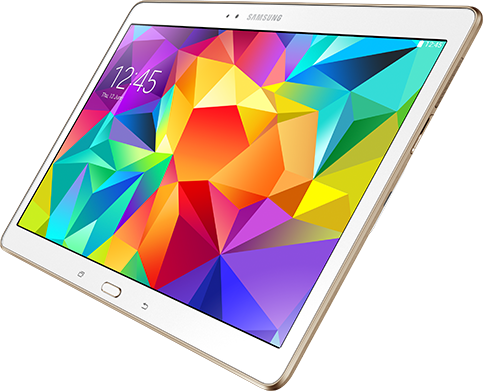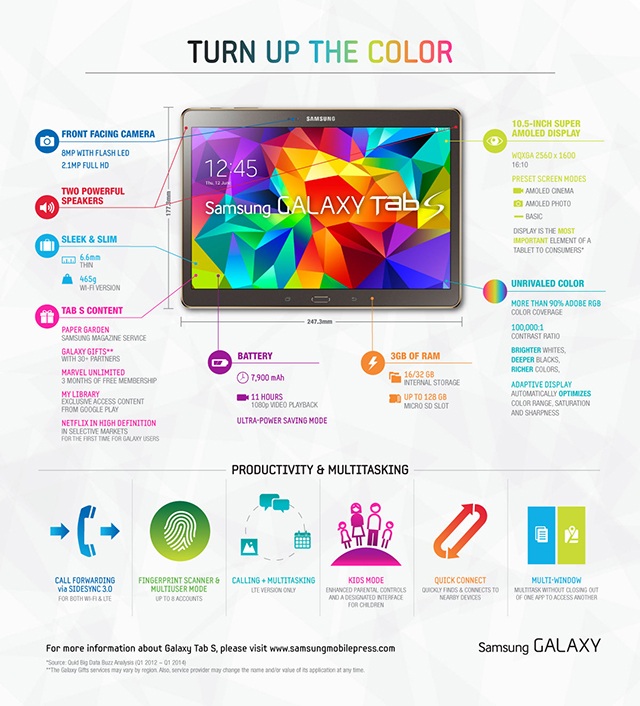Samsung Galaxy Tab S: Can it beat the iPad?

Samsung has unwrapped a new line of Android tablets, the Galaxy Tab S, which the South Korean giant is touting as the “best tablet that it has ever made” and is set to compete directly with Apple’s iPad.
The Galaxy Tab S will arrive in two different flavours, an 8.4-inch model and a slightly larger 10.5-inch version. Both models will have 16GB or 32GB internal storage options in addition to 4G and Wi-Fi variants.
Samsung’s latest tablet is, in many ways, a massive Galaxy S5 right down to the fingerprint scanner on the home button and dimpled pattern back. Unfortunately, it also inherits the same plastic build, but it’s at least a millimetre thinner and a touch lighter than the iPad Air while still managing to squeeze in a larger 10.5-inch display.
Samsung rather confusingly claims that the Galaxy Tab S is their first true premium model tablet and this would be true had it not been for the release of the Galaxy NotePRO and TabPRO line earlier this year. After all, those tablets share the same processing power and screen resolution with the Galaxy Tab S.
Turbo-charged consumption
Admittedly, the NotePRO and TabPRO lines skew more towards the professional market with productivity features at the forefront whereas the consumer centric Galaxy Tab S is clearly aimed as a content consumption-first device. Semantics aside, we can safely say that the Tab S is Samsung’s first true high-end consumer tablet.
The first indicator of Samsung’s renewed focus on content consumption is the lack of S Pen stylus support and aggressive pursuit of content partners.
Out of the gate, Galaxy Tab S customers will have access to over 30 different mobile content providers in the form of free subscriptions and other premium content. Some of these include:
Free 3 month subscription to Marvel Unlimited and its library of over 15,000 comic books; a free ebook every month from the Amazon Kindle store; 12 month subscription to Bloomberg Businessweek, 6 month subscriptions to The Economist, The Wall Street Journal, The Washington Post and LIVESPORT.TV; Premium subscriptions to Evernote, LinkedIn and Cisco WebEX Meetings; and select entertainment content from the Google Play store.
Eye-popping display
The second is the emphasis on the display. According to Samsung, the Galaxy Tab S comes with the highest quality display that is unrivalled in the industry.
"The tablet is becoming a popular personal viewing device for enjoying content, which makes the quality of the display a critical feature,” said JK Shin, CEO and President of IT & Mobile Division, Samsung Electronics. “With the launch of the Galaxy Tab S, Samsung is setting the industry bar higher for the entire mobile industry.”
It’s hard to argue with Samsung on this one. The Galaxy Tab S is the first full-sized tablet on the market to use an eye-melting AMOLED display as opposed to the LCD panels we normally see on tablets. That’s right, those deep blacks, brighter whites and unmistakably vivid colours are finally making their way to the tablet market. At the press event, Samsung put the Tab S side by side with the iPad Air, which possess one of the best LCD panels on the market, and the difference in picture quality was impressive.
At 2560 x 1600 resolution, the display is also sharper, equating to 288 pixels per inch (PPI) for the 10.5-inch and 359 PPI for the 8.4-inch version.
Another plus for Samsung’s AMOLED display is that it is significantly brighter than competing tablets, which should result in a device that is actually usable outdoors in bright sunlight. What’s more, the company has embedded a tiny RGB sensor inside the bezels of the Tab S that adjusts not only the brightness but the colour saturation, white balance and sharpness of the display as well all of which will be tweaked on the fly to suit the specific ambient lighting situation you might be in.

New additions to the Galaxy universe
On the software front, Samsung hasn’t made any wholesale changes to TouchWiz, but it has introduced some interesting new features that tie in the Galaxy ecosystem.
‘SideSync’ wirelessly pairs and mirrors your Galaxy smartphone directly on the screen of the Tab S, allowing you to take calls, send texts, share files and perform other smartphone related tasks on the tablet while your Galaxy smartphone is in another room or buried in a bag. SideSync uses Wi-Fi Direct and doesn’t require an internet connection to work. The versions running off the demo units looked quite cumbersome to use and were rife with delays, but it will be interesting to see how it all comes together in the final retail version.
The other notable feature is the ‘Multi User Mode’ that can handle up to eight different login accounts on the Tab S, complete with fingerprint authentication. We were disappointed in the performance of the fingerprint scanner on the Galaxy S5, but Samsung says that they have been working hard to improve the sensor on the Tab S.
Of course, any flagship tablet worth its salt needs to carry a range of accessories and Samsung has that covered with an origami style ‘Book Cover’ that can be configured to three different display angles for typing or watching content. Samsung has also taken a few cues from Asus’s Transformer line with a Bluetooth keyboard cover that effectively turns the tablet into a notebook.
Samsung is gearing up for a global release in July and while there’s no word yet on local pricing, the Tab S will be launching in the US at $US399 for the 8.4-inch model and $US499 for the 10.5-inch version.
Expect a final judgment on Samsung’s response to the iPad closer to launch.
















